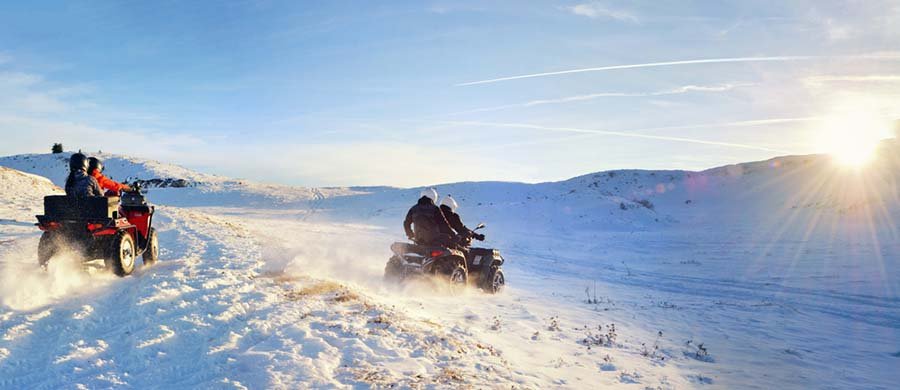If you’re thinking about riding your ATV in the snow, you will need to do some prep work before you venture out into the wilderness. Riding an ATV can be dangerous in even normal conditions. Make sure youre wearing the proper safety gear because conditions can get even worse when there’s snow on the ground. So, what do you need to know before riding your all-terrain vehicle in a winter wonderland? From using an off-road communication device to checking the weather, this guide will help you stay safe in all kinds of snowy conditions!
Table of Contents
Bundle Up
The cold is one of the biggest obstacles to riding your ATV in the winter. You’ll need to wear warm, insulating layers to keep your body temperature up when the snow starts to fall. Start with a moisture-wicking underlayer that will dry quickly if you start to sweat. A good option would be polyester or wool which tend to work well. You will then need at least one middle layer such as a fleece to keep your body heat in. Finish with waterproof outer layers that will keep the moisture at bay, including gloves, boots, snow pants, and a jacket. Extend your sleeves into your gloves and use long socks that go up your pants to create a waterproof seal. Use a neck gaiter or face mask to protect any exposed regions from the cold air.
Wear the Proper Gear
Once you have all your layers on, you should finish the job by adding the proper safety gear, including a full-face or half-face helmet with goggles. ATVs can easily flip over at high speeds, and the snow can make the vehicle even harder to control. Use a helmet that fits to protect your head and neck from injury. The visor on the helmet or goggles will block the glare of the sun to increase visibility.
You should also be able to communicate while riding an ATV so you can coordinate with your group and fellow riders. You should never take your hands off the wheel to send a signal to your friends. Use a helmet communication device to keep in touch safely every step of the way. It fits seamlessly onto your helmet without obstructing your view of the path. Just speak into the receiver to send a message to your companions or access the features of your phone. You can also call for help in an emergency, so your friends know exactly where to find you.
The device uses what’s known as dynamic mesh communication to automatically connect to anyone in your party who’s in range. You don’t have to manually reset the connection. Just speak into the device to stay focused on the task at hand.

Group of female and man driving quad bike on top of the mountain at sunset
Check the Weather
The weather forecast will either make or break your next playdate in the snow. Use your off-road communication device to sync up with the latest weather report. Sign up for local alerts so you can turn back when the weather takes a turn for the worse. Avoid riding in blizzard and white-out conditions as you won’t be able to see where you’re going. Major winter storms can also leave your ATV buried under the snow. All those extra inches of powder will also make it harder to drive. Your vehicle won’t have as much traction when the snow reaches a certain height.
Keep an eye on the temperature as well. Riding when it’s below 32 degrees Fahrenheit will increase the risk of frostbite and hypothermia. Check your owner’s manual on the ATV to see if it can still operate in freezing temperatures.
Prepare and Modify Your ATV
The average ATV is made to be driven on all types of terrain, including the snow, but your vehicle may still need some additional modifications to get through a heavy snowfall. Your ATV should be able to handle up to two feet of snow with the right equipment.
Consider adding a plow to the front of the vehicle to move large batches of snow out of your way. Pushing the snow to the side is usually safer than trying to drive over it. The ATV may lose traction, leaving you stranded in the middle of nowhere.
You may want to add an engine block heater to make it easier to start the engine in the winter. It supplies a steady stream of warm air to the engine to make sure the air and fuel reach the proper temperature for combustion.

Photo of attractive young man in red warm winter clothes and black helmet with arms open on the ATV 4wd quad bike stand in heavy snow with deep wheel track. Freedom concept.
Swap out your factory tires for snow or all-terrain tires with large tread patterns, raised ribs, and radial patterns. These features improve traction and handling in snowy conditions to help you stay in control of the vehicle. It may be beneficial to also consider bringing along a winch, traction pads, or resistance bands in case you get stuck.
Riding your ATV in the winter can be a great way to enjoy the changing scenery. Use these tips to make the most of your time in the snow and make sure you can get home safe and sound.










